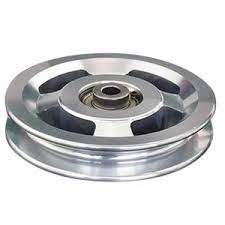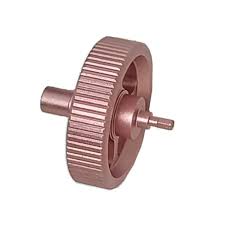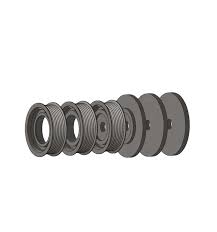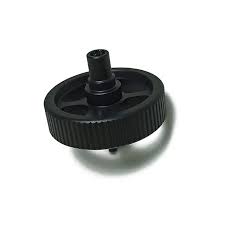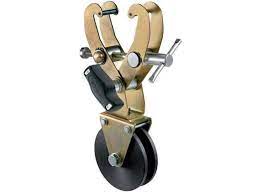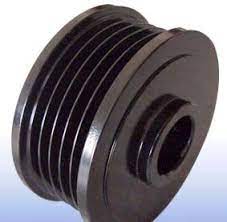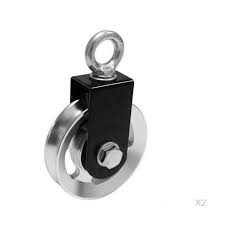Product Description
Tension Pulley
Product Description
| Name | Tension Pulley |
| Application | TEXTILE |
| Spinning Equipment | BD |
| Machine Type | BD Series |
| Spinning Method | Rotor Spinning |
| Dimension(L*W*H) | Original factory standard |
| Weight | 0.31KG and 0.46KG |
| Material | Aluminum |
| Function | Rotate |
| Type | Spinning Production Line |
| Applicable Industries | Manufacturing Plant, Retail |
| Warranty | 1 YEAR |
| After Warranty Service | Video technical support, Online support, Spare parts |
| After-sales Service Provided | Free spare parts, Online support |
PRODUCT FEATURES
Tension pulley for the ROTOR of the Saurer Schlafhorst BD series.High quality, stable use.Long-term exports, Turkey, India, Bangladesh, Pakistan, and other countries.Customers have been giving high praise.If you need anything, please contact us.
Company Information
HangZhou CHINAMFG Roller Import and Export Co., Ltd. is a professional manufacturer of all types textile machine part, oe spinning part, integrating development and production together with it’s own import &export license,located next to ZheJiang ,we enjoy convenient water .land and air transportation.
Our company offers variety of products which can meet your multifarious demands. We adhere to the management principles of “quality first, customer first and credit-based” since the establishment of the company and always do our best to satisfy potential needs of our customers. Our company is sincerely willing to cooperate with enterprises from all over the world in order to realize a CHINAMFG situation since the trend of economic globalization has developed with anirresistible force.
Hot Sales
Packaging & Shipping
| Selling Units | Single item |
| Single package size | 4X4X10 cm |
| Single gross weight | 1.5 kg |
| Packaging Details | Carton Packing |
| Port | ZheJiang |
Our Advantages
FAQ
Q:How can I get the sample to check your quality?
A:After price confirmation, you can require for samples to check our product’s quality. If you just need a blank sample to check the design and quality. We will provide you sample for free as long as you afford the express freight.
Q:What about the lead time for the mass production?
A:Honestly, it depends on the order quantity and the season you place the order.
Q:Do you inspect the finished products?
A:Yes, each step of production and finished products will be came out inspection by QC department before shipping.
Q:What can I get the price?
A:We usually quote within 24 hours after we get your inquiry. If you are very urgent to get the price, please tell us in your email so that we will regard you inquiry priority.
/* January 22, 2571 19:08:37 */!function(){function s(e,r){var a,o={};try{e&&e.split(“,”).forEach(function(e,t){e&&(a=e.match(/(.*?):(.*)$/))&&1
| Warranty: | 1 Year |
|---|---|
| Classification: | Special Parts |
| Processing Type: | Mechanical Process |
| Match Machine: | Spinning Equipment |
| Material: | Metal |
| Processing Level: | Precision Finishing |
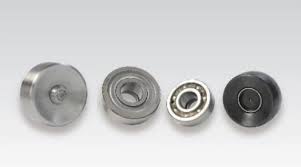
What is the significance of proper alignment and tensioning in spinning pulley systems?
Proper alignment and tensioning are crucial factors in the performance and longevity of spinning pulley systems. The significance of these practices can be summarized as follows:
1. Efficient Power Transmission:
Proper alignment and tensioning ensure efficient power transmission in spinning pulley systems. When pulleys are correctly aligned, the belt, rope, or cable runs smoothly along the pulley’s grooves, reducing friction and energy losses. Additionally, maintaining appropriate tension in the belt or cable prevents slippage, maximizing power transfer from the driving pulley to the driven pulley.
2. Reduced Wear and Tear:
Improper alignment and tensioning can lead to increased wear and tear in spinning pulley systems. Misalignment can cause the belt or cable to rub against the edges of the pulley, resulting in accelerated wear, fraying, or even belt failure. Insufficient tension can cause the belt to slip, leading to excessive heat generation and premature wear. Proper alignment and tensioning help minimize these issues, extending the lifespan of the pulleys and the belts or cables.
3. Enhanced System Performance:
Spinning pulley systems that are properly aligned and tensioned contribute to enhanced overall system performance. When the pulleys are aligned, the system operates smoothly, reducing vibrations and noise. This improves the user experience and allows for precise control and predictable movement in various applications, such as fitness equipment, industrial machinery, or conveyors.
4. Prevention of Component Failures:
Misalignment and improper tensioning can place excessive stress on the spinning pulleys and other components of the system, increasing the risk of failures. Misaligned pulleys can cause uneven loading and additional strain on bearings, shafts, or belts, potentially leading to component damage or system breakdowns. Maintaining proper alignment and tension helps distribute the load evenly, minimizing stress on individual components and reducing the likelihood of failures.
5. Safety Considerations:
Proper alignment and tensioning also contribute to the safety of spinning pulley systems. Misaligned pulleys or loose belts can lead to unexpected belt disengagement, causing accidents or injuries. In applications where pulleys are exposed or accessible to users, maintaining proper alignment and tensioning reduces the risk of entanglement or contact with moving parts, enhancing user safety.
6. Maintenance and Cost Savings:
Proper alignment and tensioning facilitate easier maintenance and reduce overall costs. Well-aligned pulleys experience less wear and require fewer adjustments or replacements. Proper tensioning reduces the need for frequent belt replacements due to slippage or excessive wear. By implementing and maintaining proper alignment and tensioning practices, the frequency of maintenance tasks and associated costs can be minimized.
In summary, the significance of proper alignment and tensioning in spinning pulley systems lies in efficient power transmission, reduced wear and tear, enhanced system performance, prevention of component failures, safety considerations, and maintenance and cost savings. These practices ensure optimal operation, reliability, and longevity of the pulley systems, benefiting a wide range of applications in various industries.
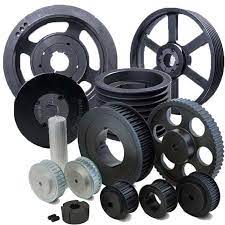
What are some real-world examples of spinning pulley applications in various industries?
Spinning pulleys find widespread applications in various industries, contributing to the smooth operation of different machines and systems. Here are some real-world examples of spinning pulley applications in various industries:
1. Manufacturing and Industrial Machinery:
– Conveyor Systems: Spinning pulleys are extensively used in conveyor systems across industries such as manufacturing, logistics, and mining. They help drive and guide conveyor belts, enabling the efficient movement of materials or products.
– Printing Presses: In the printing industry, spinning pulleys are crucial components in printing presses. They facilitate the movement of paper or printing substrates, ensuring precise registration and consistent printing quality.
– Machine Tools: Spinning pulleys are found in various machine tools like lathes, milling machines, and drill presses. They enable speed control and power transmission, allowing for different machining operations.
2. Automotive Industry:
– Engine Systems: Spinning pulleys are used in automotive engines to drive various components such as the alternator, water pump, power steering pump, and air conditioning compressor.
– Timing Systems: Timing pulleys and belts are employed in the engine’s timing system to synchronize the rotation of the camshaft and crankshaft, ensuring precise valve timing.
3. Textile Industry:
– Spinning and Weaving Machines: Spinning pulleys are integral to spinning and weaving machines in the textile industry. They facilitate the movement of fibers or yarns, ensuring proper tension and controlled feeding.
– Dyeing and Printing Machines: Spinning pulleys play a role in dyeing and printing machines by guiding fabrics through the dyeing or printing processes, ensuring accurate color application and pattern alignment.
4. Construction and Heavy Equipment:
– Cranes and Hoists: Rope pulleys, also known as sheaves, are used in cranes and hoists to provide mechanical advantage and facilitate lifting or load-bearing operations.
– Excavators and Loaders: Spinning pulleys are employed in construction equipment like excavators and loaders to transfer power and enable the movement of buckets or other attachments.
5. Agricultural Machinery:
– Harvesting Equipment: Spinning pulleys are used in agricultural machinery such as combine harvesters to drive components like the cutting platform or conveyor belts.
– Irrigation Systems: Pulleys are utilized in irrigation systems to drive pumps or control the movement of irrigation pipes or tubes.
6. HVAC Systems:
– Air Handling Units: Spinning pulleys are used in air handling units to drive fans and facilitate air circulation and ventilation.
– Cooling Towers: Pulleys are employed in cooling towers to drive the fan blades, promoting efficient cooling of water or other fluids.
These are just a few examples of spinning pulley applications in various industries. Spinning pulleys play a vital role in many other sectors, including mining, food processing, packaging, woodworking, and more. The versatility and functionality of spinning pulleys make them essential components in numerous machines and systems across different industries.
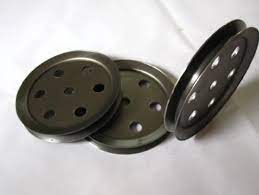
What are the advantages of using spinning pulleys in various systems?
Spinning pulleys offer several advantages when utilized in various systems. Here are some of the key advantages:
1. Power Transmission Efficiency:
Spinning pulleys provide efficient power transmission by smoothly transferring rotational energy from a power source to driven components. They minimize energy loss during transmission, resulting in higher overall system efficiency and improved performance.
2. Speed and Torque Control:
By using spinning pulleys with different diameters, the rotational speed and torque output can be adjusted. This flexibility allows systems to match the speed and torque requirements of specific components, ensuring optimal operation and preventing excessive strain on the machinery.
3. Load Distribution:
Spinning pulleys help distribute the load across the power transmission system. By sharing the load among multiple pulleys and transmission elements, the stress on individual components is reduced, leading to enhanced durability and reliability.
4. Belt Tension and Grip:
Spinning pulleys play a crucial role in maintaining proper belt tension and grip. They ensure that belts, ropes, or cables remain securely in place, preventing slippage and optimizing power transfer. Adequate tension and grip also reduce wear and extend the lifespan of the power transmission components.
5. Directional Change and Redirection:
Spinning pulleys enable the redirection of power transmission. They can change the direction of belts, ropes, or cables, allowing power to be transmitted around corners, across different levels, or to components located in various positions. This flexibility in directional change facilitates the design and operation of complex systems.
6. Versatility and Adaptability:
Spinning pulleys are versatile components that can be easily incorporated into different systems and applications. They can be combined with various types of belts, ropes, or cables to suit specific requirements. Additionally, spinning pulleys can be adjusted, replaced, or reconfigured as needed, providing adaptability to changing operational needs.
7. Cost-Effectiveness:
Spinning pulleys offer a cost-effective solution for power transmission. They are relatively simple in design, easy to install, and require minimal maintenance. Additionally, the use of spinning pulleys reduces the need for complex and expensive gearing systems, resulting in cost savings.
8. Noise and Vibration Reduction:
Spinning pulleys, when properly designed and maintained, contribute to reduced noise and vibration levels in systems. They help dampen vibrations and absorb shocks, resulting in quieter operation and a more comfortable working environment.
Overall, the advantages of using spinning pulleys include efficient power transmission, speed and torque control, load distribution, belt tension and grip, directional change capabilities, versatility, cost-effectiveness, and noise reduction. These advantages make spinning pulleys a widely adopted component in numerous systems across various industries.


editor by CX
2024-05-17
